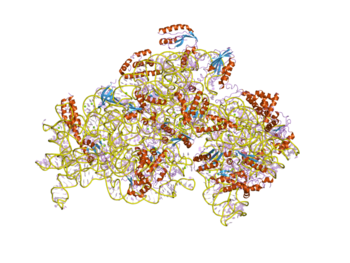| S4 | |||||||||
|---|---|---|---|---|---|---|---|---|---|
 | |||||||||
| Identifiers | |||||||||
| Symbol | S4 | ||||||||
| Pfam | PF01479 | ||||||||
| Pfam clan | CL0492 | ||||||||
| InterPro | IPR002942 | ||||||||
| PROSITE | PDOC00549 | ||||||||
| SCOP2 | 1c06 / SCOPe / SUPFAM | ||||||||
| CDD | cd00165 | ||||||||
| |||||||||
In molecular biology, S4 domain refers to a small RNA-binding protein domain found in a ribosomal protein named uS4 (called S9 in eukaryotes). The S4 domain is approximately 60-65 amino acid residues long, occurs in a single copy at various positions in different proteins and was originally found in pseudouridine syntheses, a bacterial ribosome-associated protein.
The S4 protein helps to initiate assembly of the 16S rRNA. In this way proteins serve to organise and stabilise the rRNA tertiary structure.
Function
The function of the S4 domain is to be an RNA-binding protein. S4 is a multifunctional protein, and it must bind to the 16S ribosomal RNA. In addition, the S4 domain binds a complex pseudoknot and represses translation. More specifically, this protein domain delivers nucleotide-modifying enzymes to RNA and to regulates translation through structure specific RNA binding.
Structure
The S4 protein domain is composed of three alpha helices and five beta strands. It is organized as an antiparallel sheet in a Greek key motif.
References
- ^ Aravind L, Koonin EV (March 1999). "Novel predicted RNA-binding domains associated with the translation machinery". J. Mol. Evol. 48 (3): 291–302. doi:10.1007/pl00006472. PMID 10093218. S2CID 8083860.
- Maguire BA, Zimmermann RA (March 2001). "The ribosome in focus". Cell. 104 (6): 813–6. doi:10.1016/s0092-8674(01)00278-1. PMID 11290319. S2CID 8174178.
- Chandra Sanyal S, Liljas A (December 2000). "The end of the beginning: structural studies of ribosomal proteins". Curr. Opin. Struct. Biol. 10 (6): 633–6. doi:10.1016/S0959-440X(00)00143-3. PMID 11114498.
- Davies C, Gerstner RB, Draper DE, Ramakrishnan V, White SW (1998). "The crystal structure of ribosomal protein S4 reveals a two-domain molecule with an extensive RNA-binding surface: one domain shows structural homology to the ETS DNA-binding motif". EMBO J. 17 (16): 4545–58. doi:10.1093/emboj/17.16.4545. PMC 1170785. PMID 9707415.